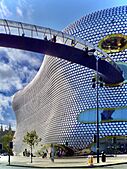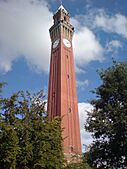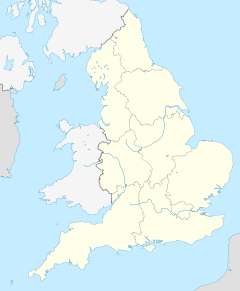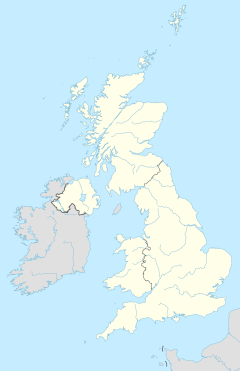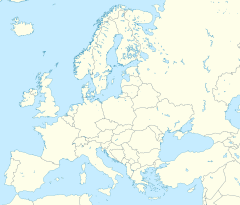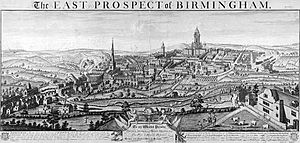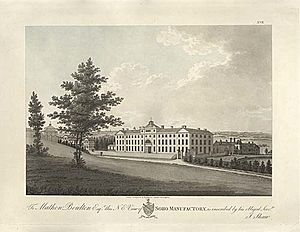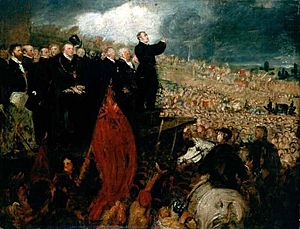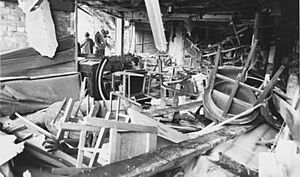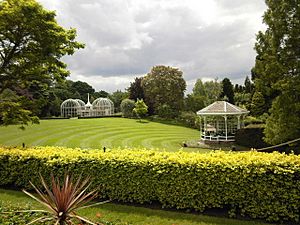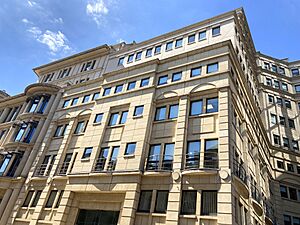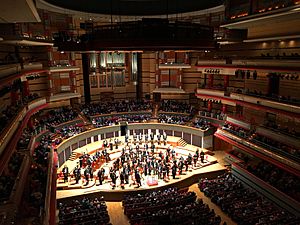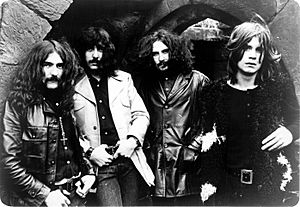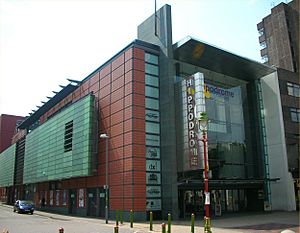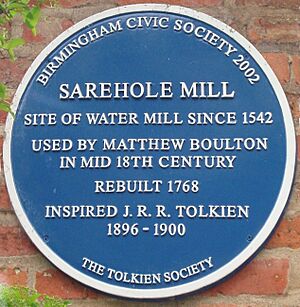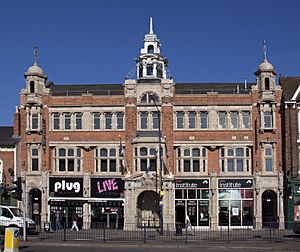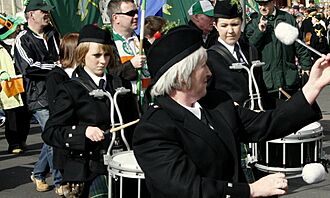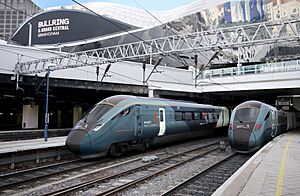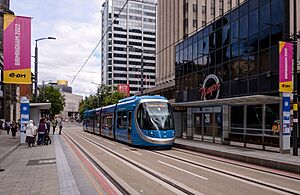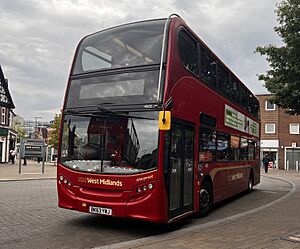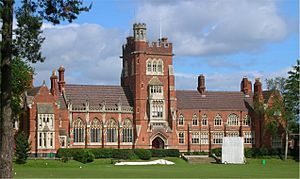Birmingham facts for kids
Quick facts for kids
Birmingham
|
|||
|---|---|---|---|
|
Birmingham skyline
Council House in Victoria Square
Stephenson Place on New Street
Selfridges Building in the Bullring Shopping Centre
Old Joe at the University of Birmingham
|
|||
|
|||
Nickname(s):
|
|||
| Motto(s):
Forward
|
|||

Birmingham shown within West Midlands county
|
|||
| Sovereign state | United Kingdom | ||
| Country | England | ||
| Region | West Midlands | ||
| City region and ceremonial county | West Midlands | ||
| Historic county |
|
||
| Settled | c.600 | ||
| City status | 14 January 1889 | ||
| Metropolitan borough | 1 April 1974 | ||
| Administrative HQ | The Council House, Victoria Square | ||
| Areas and Suburbs of the city (Within 4 miles) |
List
Alum Rock
Ashted Aston Balsall Heath Birchfield Bordesley Bordesley Green Brindleyplace Camp Hill Chinese Quarter City Centre Deritend Digbeth Duddeston Eastside Edgbaston Five Ways Gib Heath Gosta Green Gun Quarter Handsworth Handsworth Wood Highgate Hockley Jewellery Quarter Ladywood Lee Bank Lozells Nechells Newtown Pelham Rotton Park Saltley Small Heath Smithfield Soho Southside South Yardley Sparkbrook Sparkhill Ward End Westside Winson Green Witton |
||
| Government | |||
| • Type | Metropolitan borough with leader and cabinet | ||
| • Body | Birmingham City Council | ||
| Area | |||
| • City and metropolitan borough | 103.4 sq mi (267.8 km2) | ||
| • Metro | 348 sq mi (902 km2) | ||
| Area rank | 151st | ||
| Population
(2005 est.)
|
|||
| • City and metropolitan borough | 1,141,816 | ||
| • Rank | 1st | ||
| • Urban | 2,590,363 | ||
| • Metro | 4.3 million | ||
| Demonym(s) | Brummie | ||
| GDP | |||
| • City and metropolitan borough | £35.367 billion (2022) | ||
| • Per head | £30,552 (2022) | ||
| • Metro | £85.192 billion (2022) | ||
| Time zone | UTC+0 (GMT) | ||
| • Summer (DST) | UTC+1 (BST) | ||
| Postcode area |
B
|
||
| Dialling code | 0121 | ||
| ISO 3166 code | GB-BIR | ||
| GSS code | E08000025 | ||
| ITL code | TLG31 | ||
Birmingham (![]() i/ˈbɜːrmɪŋəm/ bur-MING-əm) is a large city and metropolitan borough in the West Midlands area of England. It is the second-largest city in Britain, often called the second city of the United Kingdom. About 1.158 million people live in the city itself. Birmingham is next to the Black Country to its west. Together with cities like Wolverhampton and towns such as Dudley and Solihull, it forms the West Midlands conurbation, a large urban area.
i/ˈbɜːrmɪŋəm/ bur-MING-əm) is a large city and metropolitan borough in the West Midlands area of England. It is the second-largest city in Britain, often called the second city of the United Kingdom. About 1.158 million people live in the city itself. Birmingham is next to the Black Country to its west. Together with cities like Wolverhampton and towns such as Dudley and Solihull, it forms the West Midlands conurbation, a large urban area.
Birmingham is in the West Midlands region of England. It is seen as a key place for social life, culture, business, and finance in the Midlands. The city is mostly flat, with small rivers like the River Tame and its branches, the River Rea and River Cole. However, Birmingham is famous for its many canals, which are called the Birmingham Canal Navigations.
Long ago, Birmingham was a small market town in Warwickshire. It grew a lot in the 1700s during the Midlands Enlightenment, a time of big changes in science, technology, and business. This period led to many new ideas that shaped modern industry. By 1791, people called it "the first manufacturing town in the world." Birmingham was special because it had many small workshops where people did skilled trades. This helped the city become very creative and successful for a long time. The famous Watt steam engine was even invented here.
Birmingham's strong economy also led to new ideas in politics. Leaders like Thomas Attwood and Joseph Chamberlain helped Birmingham play a big role in developing British democracy. During World War II, from 1940 to 1943, German planes bombed Birmingham heavily in what was known as the Birmingham Blitz. After the war, the city was rebuilt with many new buildings.
Today, Birmingham's economy is mostly based on services. It is a major international business hub and important for transport, shopping, events, and conferences. Its economy is the second-largest in the UK outside London. Birmingham has five universities, including the University of Birmingham, making it a huge centre for higher education. The city is home to famous cultural groups like the City of Birmingham Symphony Orchestra and the Birmingham Royal Ballet. Birmingham also hosted the 2022 Commonwealth Games. In 2021, it was the third most visited city in the UK by people from other countries.
Contents
- The Name of Birmingham
- Birmingham's History
- Birmingham's Geography
- Green Spaces in Birmingham
- People of Birmingham
- Birmingham's Economy
- Birmingham's Culture
- Food and Drink in Birmingham
- Buildings and Design
- How People Call Birmingham
- Getting Around Birmingham
- Education in Birmingham
- Public Services
- Sports in Birmingham
- Media in Birmingham
- International Friends
- Images for kids
- See also
The Name of Birmingham
The name Birmingham comes from an old English word, Beormingahām. This means the home or settlement of the 'Beormingas', who were a tribe or clan. Their name likely meant 'Beorma's people'. This type of place name suggests that Birmingham was probably settled by the early 600s. Other nearby places with names like '-tūn' (farm) or '-lēah' (woodland clearing) were likely built later as the population grew.
Birmingham's History
Early Times and Middle Ages
People have lived in the Birmingham area for a very long time, with signs of human activity from around 8000 BC. During the Bronze Age, between 1700 BC and 1000 BC, more people settled here. When the Romans came to Britain in the 1st century, they built a fort called Metchley Fort in what is now Edgbaston around AD 48. Birmingham was later founded by the Beormingas tribe around the 6th or 7th century. It was a small village in the Arden forest area.
Birmingham started to become a big town in 1166. That's when Peter de Bermingham, the local lord, got permission to hold a market at his castle. He then planned a market town around the area now known as the Bull Ring. This made Birmingham an important trading centre as the area's economy grew. Within 100 years, Birmingham was a busy town of traders and craftspeople. By 1327, it was the third-largest town in Warwickshire.
Growing into a Modern Town
In the 1500s, Birmingham's main governing groups disappeared. This gave the town a lot of freedom to grow and change. Making iron goods became very important to Birmingham's economy. The town also became a centre for iron merchants who helped with money, raw materials, and selling products. By the 1600s, Birmingham was a trading hub for metal goods, selling them as far away as the West Indies. This helped local metalworkers become very skilled and make many different products.
By the time of the English Civil War in the 1640s, Birmingham was growing fast. Its people were very independent and didn't always follow old traditions. The town supported the Parliamentarians and was attacked by Royalist forces in 1643. It also became a safe place for people who didn't agree with the official church.
By 1700, Birmingham's population had grown fifteen times, making it the fifth-largest town in England and Wales. The 1700s saw a time of great ideas and teamwork called the Midlands Enlightenment. Birmingham became a key place for art, music, and theatre. Important thinkers, especially those from the Lunar Society of Birmingham, shared new ideas in science and philosophy. Because many of these thinkers were also manufacturers, like Matthew Boulton, new scientific ideas quickly turned into practical inventions and technologies. This led to a "chain reaction of innovation" that helped start the Industrial Revolution.
The Industrial Revolution

Birmingham's huge industrial growth began earlier than in other factory towns. It was different because it focused on skilled workers making many different products in small workshops, rather than unskilled workers making one product in big factories. This led to amazing inventions. Between 1760 and 1850, Birmingham residents registered three times more patents (new inventions) than any other British city.
The need for money to support this growth made Birmingham a major financial centre. Lloyds Bank was founded here in 1765, and Ketley's Building Society, the world's first building society, started in 1775.
Many important inventions came from Birmingham. In 1709, Abraham Darby I used coke to smelt iron, which changed how cast iron was made. In 1732, Lewis Paul and John Wyatt invented roller spinning for the cotton industry, and in 1741, they opened the world's first cotton mill in Birmingham. In 1746, John Roebuck invented a way to make sulphuric acid in large amounts, starting the modern chemical industry.
But the most important invention was the industrial steam engine developed by James Watt and Matthew Boulton in 1776. This invention changed manufacturing forever, allowing factories to produce much more than before.
Victorian Era and Beyond
In the early 1800s, Birmingham became important in politics, fighting for people's rights to vote. Thomas Attwood and the Birmingham Political Union helped bring about the Great Reform Act in 1832, which gave more people the right to vote.
Birmingham continued to innovate. It was the end point for the world's first two long-distance railway lines in 1837 and 1838. A Birmingham schoolteacher, Rowland Hill, invented the postage stamp in 1839. Alexander Parkes invented the first human-made plastic in the Jewellery Quarter in 1855.
By the 1820s, a large canal system was built, helping industries get resources. During the Victorian era, Birmingham's population grew to over half a million. Queen Victoria officially made Birmingham a city in 1889. Important political figures like Joseph Chamberlain and his son Neville Chamberlain (who later became Prime Minister) lived in Birmingham. The city also opened its own university in 1900.
The 20th Century and Today

During World War II, Birmingham was heavily bombed in the "Birmingham Blitz". The city was also where two key scientific discoveries for the war were made: how to build a nuclear weapon (by Otto Frisch and Rudolf Peierls in 1940) and the cavity magnetron (by John Randall and Henry Boot), which was vital for radar and later microwave ovens.
After the war, in the 1950s and 1960s, much of Birmingham was rebuilt. This included new tower blocks and the redevelopment of the Bull Ring and New Street station. Many people from the Commonwealth of Nations and other countries moved to Birmingham, changing the city's population.
In 1974, 21 people died and 182 were hurt in bomb attacks. Six men, known as the Birmingham Six, were wrongly convicted and later cleared after 16 years. The real people responsible have not been caught.
Birmingham was a very rich city until the 1970s. However, government policies tried to limit its growth, which hurt its ability to create new businesses. The city became very reliant on the car industry. In the early 1980s, Birmingham's economy struggled, leading to high unemployment.
Since the year 2000, many parts of Birmingham have been transformed. The Bullring Shopping Centre was redeveloped, and the new Library of Birmingham (the largest public library in Europe) was built. Old industrial areas like Brindleyplace and The Mailbox have also been renewed. In 1998, Birmingham hosted the 24th G8 summit, a meeting of world leaders. The city also successfully hosted the 2022 Commonwealth Games.
On 5 September 2023, the Birmingham City Council announced that it could not meet its financial commitments. This meant the council was in a very difficult financial situation. This was due to large payments for equal pay claims, ongoing costs, and problems with a new computer system.
Birmingham's Geography
Birmingham is in the middle of the West Midlands region of England. It sits on the Birmingham Plateau, which is higher ground. The city has small rivers like the River Tame, Cole, and Rea. Birmingham is far from the sea.
The city of Birmingham is part of a larger urban area that includes Solihull and the industrial towns of the Black Country. This whole area is called the West Midlands Built-up Area. Birmingham's wider metropolitan area also includes towns like Tamworth and cities like Lichfield and Coventry.
Birmingham is about 100 miles north-west of London. Much of the city was once part of the ancient Forest of Arden. Many places in Birmingham, like Moseley and Yardley, still have lots of oak trees.
Birmingham's Weather
Birmingham has a mild, wet climate, like most of the UK. Summers are warm, with average high temperatures around 21.3°C in July. Winters are cool, with average high temperatures around 6.7°C in January. The highest temperature ever recorded was 37.4°C on 19 July 2022.
Birmingham gets more snow than some other big UK cities because it's inland and higher up. Extreme weather is rare, but tornadoes have happened. In July 2005, a strong tornado caused damage in the south of the city.
Green Spaces in Birmingham
Birmingham has 571 parks, more than any other European city. These parks cover over 3,500 hectares of public green space. The city has more than six million trees. Sutton Park in the north of the city is Europe's largest urban park and a national nature reserve. The Birmingham Botanical Gardens are close to the city centre.
Many green areas in the city are part of the green belt. This policy helps stop the city from spreading too much and protects natural land. These areas include Sutton Park and other country parks like Kingfisher and Woodgate Valley.
People of Birmingham
In 2021, 1,144,900 people lived in Birmingham. This was an increase of about 6.7% from 2011. Birmingham is the 27th largest city in Europe by population within its city limits. The larger urban area, which includes nearby towns, had a population of 2.3 million in 2004. About 26.7% of Birmingham's population in 2021 were born outside the UK, making it a city with many people from other countries.
Different Cultures in Birmingham
| Ethnicity of Birmingham residents, 2021 | ||||
|---|---|---|---|---|
| White | 48.7% | |||
| Asian | 31% | |||
| Black | 10.9% | |||
| Mixed | 4.8% | |||
| Other | 4.6% | |||
| Arab | 1.7% | |||
| Source: 2021 census | ||||
The 2021 census showed that 48.7% of people in Birmingham were White. 31% were Asian, 10.9% were Black, and 4.8% were of Mixed race. The largest groups born outside the UK came from Pakistan, India, Bangladesh, Romania, and Jamaica.
Birmingham has a very large community of Asian people, especially from Pakistani, Indian, and Bangladeshi backgrounds. There are also many people of Afro-Caribbean descent and a strong Chinese community. Birmingham also has a long history with Ireland, and the city has the largest Irish population in mainland Britain, with its own Irish Quarter in Digbeth.
Age of Residents
In Birmingham, 65.9% of people are between 15 and 64 years old. This is higher than the average for England and Wales. Also, 20.9% of the population is under 15, which is higher than the national average. Only 13.1% are over 65, which is lower than the national average. Birmingham is one of the youngest cities in Europe, with 40% of its people under 25. The average age is 34, which is younger than the national average of 40.
Religion in Birmingham
Religion in Birmingham (2021) Christianity (34.0%) No Religion (24.1%) Islam (29.9%) Sikhism (2.9%) Hinduism (1.9%) Buddhism (0.4%) Judaism (0.1%) Other Religions (0.6%) Religion not Stated (6.1%)
Christianity is the largest religion in Birmingham, with 34% of residents identifying as Christians in the 2021 Census. The city has a very diverse mix of religions. Outside London, Birmingham has the UK's largest Muslim, Sikh, and Buddhist communities. It also has the second largest Hindu community and the seventh largest Jewish community.
St Philip's Cathedral became a cathedral in 1905. There are two other cathedrals: St Chad's (Catholic) and the Greek Orthodox Cathedral. The oldest synagogue still standing is the 1825 Severn Street Synagogue. The Birmingham Central Mosque, one of Europe's largest, was built in the 1960s. The Guru Nanak Nishkam Sewak Jatha Sikh Gurdwara was built in Handsworth in the late 1970s.
Birmingham's Economy
Birmingham became famous for making things and engineering. Today, its economy is mostly based on services, which employed 88% of the city's workers in 2012. Birmingham is the biggest centre in the UK for jobs in public administration, education, and health. It's also the second-largest centre outside London for financial and business services.
The Gun Quarter is an area that was once a major centre for making guns. The first gun maker in Birmingham was recorded in 1630. Many buildings in this area are now being redeveloped.
The wider economy of the Birmingham area is the second-largest in the UK. Big companies like IMI plc and Mobico Group have their main offices in Birmingham. The city also has major venues like the National Exhibition Centre and International Convention Centre, which attract many conferences and exhibitions.
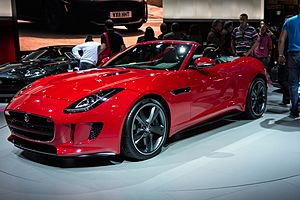
In 2012, making things (manufacturing) accounted for 8% of jobs in Birmingham. Major factories include Jaguar Land Rover in Castle Bromwich and Cadbury in Bournville. Traditional industries still exist; 40% of the UK's jewellery is made in the city's Jewellery Quarter.
Birmingham's economy has been growing. In 2015, its economic output grew by 4.2%. Birmingham has the most new businesses starting up outside London.
| Year | GVA (£ million) |
Growth (%) |
|---|---|---|
| 2010 | 20,795 | |
| 2011 | 21,424 | |
| 2012 | 21,762 | |
| 2013 | 22,644 | |
| 2014 | 23,583 | |
| 2015 | 24,790 |
However, there are also big differences in wealth in Birmingham. Unemployment is high in some areas, and many people live in deprived parts of England. Only 49% of women have jobs, compared to 65% nationally.
Despite this, Birmingham's quality of life has been improving. In 2019, it was ranked 49th in the world for quality of life. The Big City Plan aims to make the city even better by 2026. Birmingham is also seen as a top place to invest in property.
Birmingham's Culture
Music Scene
The City of Birmingham Symphony Orchestra plays at Symphony Hall. Other orchestras include the Birmingham Contemporary Music Group. The Birmingham Triennial Music Festivals, held from 1784 to 1912, featured famous composers like Mendelssohn and Edward Elgar.
Jazz music has been popular in Birmingham since the 1920s, with many festivals.
In the 1960s, Birmingham had a lively music scene, with bands like The Move and The Moody Blues becoming famous. The city was also a birthplace for heavy metal music, with pioneering bands like Black Sabbath and Judas Priest forming here. Half of the band Led Zeppelin also came from Birmingham.
Later, bands like Napalm Death and Godflesh emerged. Birmingham is also where modern bhangra music started in the 1960s. The 1970s saw the rise of reggae and ska bands like Steel Pulse and UB40, who sang about racial unity. Other popular bands from Birmingham include Duran Duran and The Streets. Many famous musicians, like Ozzy Osbourne and Jeff Lynne, grew up in the city.
Theatre and Performing Arts
Birmingham Repertory Theatre is Britain's oldest producing theatre. Other theatres include the Blue Orange Theatre and the Old Rep. Large touring shows come to the Alexandra Theatre and the Birmingham Hippodrome.
The Birmingham Royal Ballet is one of the UK's main ballet companies and performs at the Birmingham Hippodrome. The Birmingham Opera Company is known for its unique shows in unusual places like factories. The first comedy club outside London, The Glee Club, opened in Birmingham in 1994.
Literature and Authors
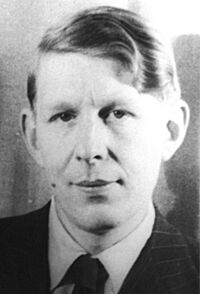
Many famous writers have links to Birmingham. Samuel Johnson stayed here, and Arthur Conan Doyle worked in Aston. The poet W. H. Auden grew up in Harborne.
The author J. R. R. Tolkien, who wrote The Lord of the Rings, grew up in Kings Heath. He called Birmingham his home town. There's a "Tolkien Trail" in Birmingham that visits places that inspired his books.
Birmingham has a lively modern writing scene, with authors like David Lodge and Jonathan Coe.
Art and Design
The Birmingham School of landscape artists started in the 1760s. Later, Birmingham became an important centre for Victorian art, especially the Pre-Raphaelite and Arts and Crafts movements. Famous artists included Edward Burne-Jones.
Birmingham's history as a manufacturing city also led to strong traditions in graphic design and product design. Famous designs from Birmingham include the Baskerville font and the Mini car.
Museums and Galleries

Birmingham has two main public art collections. Birmingham Museum & Art Gallery is famous for its Pre-Raphaelites collection. It also has old master paintings and metalwork. The Barber Institute of Fine Arts has a collection of Western art from the 13th century to today.
Birmingham Museums Trust runs other museums like Aston Hall and the Museum of the Jewellery Quarter. The Birmingham Back to Backs show how people used to live in the city. Cadbury World is a museum about chocolate. The Ikon Gallery shows modern art.
Thinktank is Birmingham's main science museum. It has a planetarium and the Smethwick Engine, the world's oldest working steam engine. Other science museums include the National Sea Life Centre.
Nightlife and Entertainment
Birmingham's nightlife is mainly found around Broad Street and Brindleyplace. Other popular areas include the Arcadian and Hurst Street Gay Village. There are many clubs and bars in Digbeth, The Mailbox, and the Jewellery Quarter. Outside the city centre, Star City is a large entertainment complex.
Festivals and Events
Birmingham hosts many festivals. The city's biggest one-day event is its St. Patrick's Day parade, which is the second largest in Europe after Dublin's. The Nowka Bais is a Bengali boat racing festival. Other multicultural events include the Bangla Mela. The Birmingham International Carnival celebrates Caribbean and African culture.
The UK's largest two-day Gay Pride festival, Birmingham Pride, takes place in May. From 1997 to 2006, the city had ArtsFest, the UK's largest free arts festival. The Birmingham Tattoo is an annual military show. The Birmingham Comedy Festival features famous comedians. Since 2001, Birmingham has hosted the Frankfurt Christmas Market, which is the largest German market outside Germany and Austria.
Food and Drink in Birmingham

Birmingham's market for farm produce started in 1166. Today, the Birmingham Wholesale Markets are the largest combined wholesale food markets in the country.
Birmingham is the only city outside London with five Michelin-starred restaurants. These include Simpson's and Purnell's.
The Balti, a type of curry, was invented in Birmingham. The city is famous for its 'Balti Triangle' area. Well-known food brands that started in Birmingham include Typhoo tea, Bird's Custard, Cadbury's chocolate, and HP Sauce. The city also has many independent food businesses, which are often found at farmers' markets and street food events.
Buildings and Design
Birmingham grew mostly in the 1700s, 1800s, and 1900s. Because of this, not many very old buildings remain, but those that do are protected. There are 1,946 listed buildings in Birmingham.
You can still see parts of medieval Birmingham in old churches like St Martin in the Bull Ring. A few other buildings from the medieval and Tudor periods still stand, such as The Old Crown.
Many Georgian buildings remain, including St Philip's Cathedral and the Town Hall. The Victorian era saw a lot of building, including major public buildings like the Victoria Law Courts and the Council House.
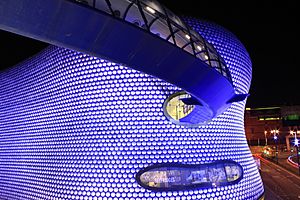
After World War II, many Victorian buildings were pulled down and replaced with modern, often brutalist buildings. However, in recent years, some of these brutalist buildings are being removed, and there's been a lot of new development. This includes the unique Selfridges building in the Bullring Shopping Centre and the Brindleyplace area.
How People Call Birmingham
People from Birmingham are called Brummies. This name comes from the city's nickname, "Brum," which comes from its old name, "Brummagem." The Brummie accent and dialect are very distinct.
Getting Around Birmingham
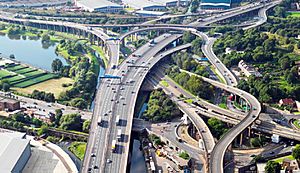
Because it's in the middle of England, Birmingham is a major hub for motorways, railways, and canals.
Roads
The city is served by the M5, M6, M40, and M42 motorways. The most famous motorway junction in the UK, Spaghetti Junction, is here. The M6 motorway passes through the city on the Bromford Viaduct, which is the longest bridge in the UK. The The Middleway (A4540) is a ring road around the city centre.
Since June 2021, Birmingham has a Clean Air Zone. This means that older, more polluting vehicles have to pay a charge to drive into the city centre.
Air Travel
Birmingham Airport is about 6 miles east of the city centre. It is the seventh busiest airport in the UK and a major base for airlines like easyJet and Jet2. You can fly from Birmingham to many places in Europe, Africa, the Americas, and Asia.
Public Transport
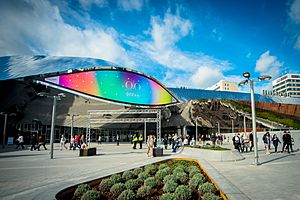
Birmingham's public transport is managed by Transport for West Midlands (TfWM). Many people use public transport to get into Birmingham, especially trains and buses.
Birmingham does not have an underground train system, which is unusual for such a large European city. However, the West Midlands Metro tram network is growing.
Trains
The main train station is Birmingham New Street. It's the busiest train station in the UK outside London. It's a national hub for long-distance trains. Birmingham Moor Street and Birmingham Snow Hill are other important stations. A new station, Curzon Street railway station, is being built for the High Speed 2 train line.
Birmingham and the surrounding area have many local train lines. There are 34 train stations within Birmingham's city limits. In 2016/2017, there were almost 55 million train journeys in the TfWM area.
Trams
Birmingham used to have a large tram system that closed in 1953. Trams returned in 1999 with the West Midlands Metro, which connects to Wolverhampton. Since 2015, the tram network runs through central Birmingham. More extensions are planned, including to Birmingham Airport.
Buses and Coaches
Bus networks are widespread across the city. National Express West Midlands operates most bus journeys in Birmingham.
The number 11 outer circle bus route, run by National Express West Midlands, is the longest urban bus route in Europe. It's over 26 miles long with 272 bus stops.
The main office of Mobico Group, which owns National Express buses, is in Digbeth. Birmingham Coach Station is also a national hub for long-distance coaches.
Cycling
National Cycle Route 5 goes through central Birmingham. In 2021, a cycle hire scheme was launched with over 300 bikes.
Canals
Birmingham still has a large canal system from the Industrial Revolution. The city has more miles of canal than Venice. Today, the canals are mainly used for fun, and areas like Brindleyplace have been redeveloped along the canals, making them a tourist attraction.
Education in Birmingham
Universities and Colleges
Birmingham has five universities: Aston University, University of Birmingham, Birmingham City University, University College Birmingham, and Newman University. In 2011, Birmingham had over 78,000 full-time students, more than any other UK city outside London. It also has the most research students outside London.
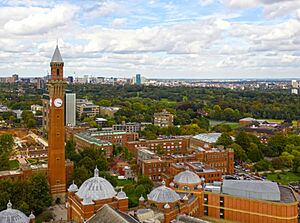
The Birmingham Business School, started in 1902, is the oldest graduate-level business school in the UK. Royal Birmingham Conservatoire offers training in music and acting.
Birmingham is also important for religious education. St Mary's College, Oscott is a Catholic seminary, and Woodbrooke is the only Quaker study centre in Europe.
Birmingham Metropolitan College is one of the largest further education colleges in the country. South & City College Birmingham and Bournville College are also big colleges in the city.
Schools
Birmingham City Council is England's largest local education authority, responsible for many schools. Most secondary schools in Birmingham are comprehensive schools for students aged 11-16/18. There are also eight state grammar schools.
King Edward's School, Birmingham, founded in 1552, is one of the city's oldest schools. Famous alumni include J. R. R. Tolkien. Other independent schools include King Edward VI High School for Girls.
Public Services
Libraries
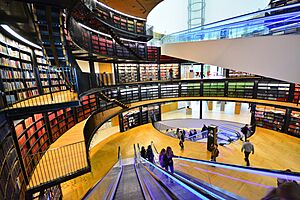
The new Library of Birmingham opened on 3 September 2013. It was designed by Dutch architects and is described as "a kind of public forum... a memorial, a shrine, to the book and to literature". It is the largest public library in the UK and the largest regional library in Europe. In 2014, over 2.4 million people visited the library.
Birmingham has 41 local libraries and a mobile library service. The library service has 4 million visitors each year.
Emergency Services
West Midlands Police handle law enforcement in Birmingham. The city's crime rate is higher than the average for England and Wales, but lower than other major English cities. West Midlands Fire Service provides fire and rescue services, and West Midlands Ambulance Service provides emergency medical care.
Healthcare

Birmingham has several major National Health Service hospitals. The Queen Elizabeth Hospital is one of the largest teaching hospitals in the UK. It has a huge critical care unit and is a national centre for organ transplants and cancer studies. It also has the Royal Centre for Defence Medicine for military personnel.
Other hospitals include Heartlands Hospital, Good Hope Hospital, and City Hospital. There are also specialist hospitals like Birmingham Children's Hospital and Birmingham Women's Hospital. Birmingham was where the first use of radiography in an operation happened, and the UK's first "hole-in-the-heart" operation was performed at Birmingham Children's Hospital.
Water and Energy
Most of Birmingham's water comes from the Elan aqueduct, which opened in 1904. Water flows by gravity from reservoirs in the Elan Valley in Wales.
The Tyseley Energy from Waste Plant burns household waste to produce electricity for the National Grid.
Sports in Birmingham
Birmingham has played a big part in modern sports. The Football League – the world's first league football competition – was founded by William McGregor, a director of Aston Villa. The modern game of tennis was developed in Edgbaston between 1859 and 1865. The Birmingham and District Cricket League is the oldest cricket league in the world. Birmingham hosted the first ever Women's Cricket World Cup in 1973.
Today, Birmingham is home to two of the country's oldest professional football teams: Aston Villa F.C. (founded 1874) and Birmingham City F.C. (founded 1875). The rivalry between them is strong, and their matches are called the Second City derby. Aston Villa plays in the Premier League, and Birmingham City plays in EFL League One.

Warwickshire County Cricket Club plays at Edgbaston Cricket Ground, which also hosts international cricket matches. It's the second-largest cricket ground in the UK after Lord's.
Birmingham also has professional Rugby Union clubs like Birmingham Moseley. The city is home to one of the oldest American football teams in the UK, the Birmingham Bulls.
Two major championship golf courses are near the city. The Belfry has hosted the Ryder Cup many times. The Alexander Stadium in Perry Barr is the headquarters of UK Athletics and hosts international athletics events. The National Indoor Arena has hosted World Indoor Championships.
Professional boxing, hockey, skateboarding, and speedway also take place in the city. Since 1994, Birmingham has hosted the All England Open Badminton Championships.
Commonwealth Games
Birmingham hosted the 2022 Commonwealth Games from 28 July to 8 August 2022. This was the first time Birmingham hosted the games. The Alexander Stadium was renovated for the opening and closing ceremonies and athletics events. The games added £1.2 billion to the UK economy.
Media in Birmingham
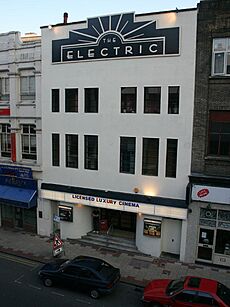
Birmingham has a media industry that includes newspapers, magazines, radio, television, and film production. Major local newspapers include the Birmingham Mail and the weekly Birmingham Post. Birmingham is also home to various national ethnic media and digital news platforms.
Birmingham has a long history with cinema. The Electric on Station Street is the oldest working cinema in the UK. Many British and international films have been shot in Birmingham.
The BBC has two facilities in the city. The Mailbox is the national headquarters for BBC English Regions and BBC Birmingham. The BBC Drama Village in Selly Oak makes television dramas.
Central/ATV studios in Birmingham used to record many ITV programmes. Now, their Birmingham output is mainly regional news.
The city has many national and local radio stations. The Archers, the world's longest-running radio soap opera, is recorded in Birmingham for BBC Radio 4.
International Friends
Birmingham is twinned with several cities around the world:
- Lyon, France (since 1951)
- Frankfurt am Main, Germany (since 1966)
- Zaporizhzhia, Ukraine (since 1973)
- Milan, Italy (since 1974)
- Leipzig, Germany (since 1992)
- Chicago, United States (since 1993)
- Johannesburg, South Africa (since 1997)
- Guangzhou, China (since 2006)
Birmingham also has friendly relations with:
Images for kids
See also
 In Spanish: Birmingham para niños
In Spanish: Birmingham para niños







